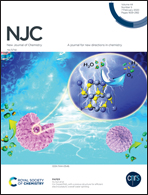Deciphering the positional impact of chlorine in a new series of berberine analogues towards the superb-selective “turn-on” hydrophobic signaling of bovine serum albumin at physiological pH†
Abstract
The optical signals of serum albumin (SA) provide precious information for realizing its native functions, in addition to developing related biomedical applications. Herein, we report a new class of easy synthesizable and water-soluble compounds (BZ1–BZ5) based on different chlorine positions on 9-O-benzyl-substituted berberine scaffolds for the selective detection of bovine serum albumin (BSA) in CP buffer solution (10 mM, pH 7.2) based on two competing factors: hydrophobic interactions and steric repulsion. The frail emission intensities of these probes were enhanced upon the addition of BSA; exceptionally, a remarkable increase in emission intensity (140-fold) and remarkable lifetime and quantum yield increases make BZ4 an excellent fluorescence turn-on hydrophobic BSA sensor. Selectivity and co-existence studies involving other proteins, free tryptophan, etc. revealed that the microenvironment around the tryptophan moiety in BSA incites drastic spectral changes upon the introduction of BSA. Moreover, the most efficient lumino-probe, BZ4, can detect bovine serum albumin at a nanomolar level (LOD = 3.3 nM) with a broadened range of linearity and slight altering of the secondary structure of the protein. Our experimental results and docking simulation studies show that the probe BZ4 binds preferentially at “binding site II” of BSA. In addition, the binding and conformational alterations of BSA provoked by these analogues have been intensely investigated, and we fruitfully relate the binding results to the sensing outcome. The obtained results reveal how the different positioning of chlorine in benzyl-substituted berberine affects the hydrophobic sensing of BSA, making these probes a new category of BSA selective material with potential applications in proteome research.



 Please wait while we load your content...
Please wait while we load your content...